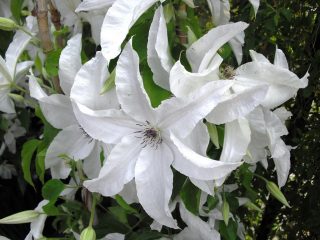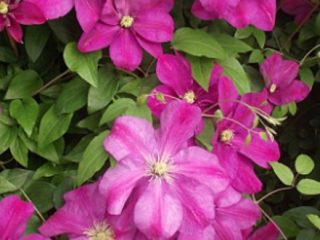Content
Pennisetum bristles is a perennial plant from the grass family. Produces numerous spikelets of burgundy, yellowish and white color. Looks beautiful both in single plantings and in compositions with flowers. The culture is heat-loving, although some varieties are highly winter-hardy. The rules for growing and using plants in landscape design are described in detail in this article.
Description of bristly pennisetum
Pennisetum bristles belongs to perennial herbaceous plants from the well-known family of cereals. The genus of the same name includes almost 150 species, which are found mainly in the warm countries of South America and Africa. One of them, pennisetum bristles Rubrum, is especially decorative. It produces dark red leaves and beautiful yellowish-lilac spikelets, as shown in the photo.

Pennisetum Rubrum is valued by gardeners for its unusual coloring.
The bristly pennisetum forms dense bushes, the height of which, depending on the variety, reaches 15-130 cm. The leaf blades are long and very narrow.They reach 50 cm (while only 0.5 cm in diameter). The color is varied - rich green in spring and summer, and turns yellow in autumn. In some varieties it is dark lilac.
The stems of the plant are erect, bare, without pubescence. The surface appears rough, and the lower part is bristly, which is why the name pennisetum is associated. The inflorescences are dense, shaped like spike-shaped panicles, and are cylindrical. The color varies depending on the type:
- burgundy;
- pink;
- white;
- pale green.
The ears of the bristly pennisetum are quite large, reaching a length of 35 cm, although they can be much smaller, for example, 3-7 cm. Each of them is covered with numerous fluffy bristles, so the bush looks very beautiful. Flowers of both sexes are formed on the ears.
Growing seedlings of bristly pennisetum from seeds
Most often, pennisetum bristles is propagated by seeds. This is a convenient way to grow both annual and perennial species. The fact is that not all plants have good winter hardiness, so some varieties have to be grown as seedlings every year.
When to plant
Sowing the seeds of bristly pennisetum should be planned for the first half of April. The fact is that the seedlings grow quite quickly, but seedlings can be transplanted into open ground only at the end of May, when there will definitely be no return frosts.
The exception is the southern regions of the country. Here, seedlings can begin to be grown at the end of March, and transplanted into open ground in mid-May. It is necessary that the soil warms up to at least +10 degrees.
Soil preparation
To grow seedlings of bristly pennisetum, it is best to use fertile soil. You can purchase it in the store or prepare it yourself in the fall. To do this, take garden soil (2 parts) and mix it with humus, sand and peat (1 part each).

To obtain a beautiful plant, seedling seeds are sown in fertile soil.
It is advisable to carry out disinfection first by watering the mixture with a 1% solution of potassium permanganate. Or you can put it in the freezer for a few days.
How to plant
The seeds of the bristly pennisetum are small, so they should be planted at a shallow depth - literally 2-3 mm. To do this, they are evenly distributed on the surface and slightly pressed. Then they water it with a spray bottle (the water must be settled), cover it with a film with holes and place the boxes in a warm, well-lit place.
Seedling care
Caring for seedlings of bristly pennisetum is standard. It includes several rules:
- During the first week after sowing, the film should be regularly removed and watered with a spray bottle.
- When seedlings appear, the shelter is finally removed and watering continues periodically.
- Install additional lighting (this is especially important if the window does not face south or east).
- 10-12 days after germination, seedlings are planted in separate peat pots.
- Then the seedlings of bristly pennisetum need to be fed with complex mineral fertilizer, for example, Agricola.
- Two weeks before transplanting into the ground, the plants begin to harden, periodically taking them out onto the balcony.
Planting in open ground
Seedlings of bristly pennisetum are planted at the end of May; for this, a well-lit area with fertile and loose soil is chosen.Loamy or sandy loam soils with a slightly acidic reaction are best suited.
If possible, the flowerbed should be protected from draft winds. It is best that it is located near bushes, a fence or other buildings. Please note that the place must be dry and not in a low area.
During landing, proceed as follows:
- Dig up and fertilize the soil in advance.
- Several shallow holes are formed at a distance of 60-80 cm.
- Water the soil in pots with seedlings of bristly pennisetum generously to form a ball of earth around the roots.
- Carefully transplant into holes, sprinkle with soil and water generously.

Pennisetum grows well in well-lit areas
To prevent this, slate or other barriers should be dug around the flowerbed to prevent root growth.
Caring for bristly pennisetum in the garden
Despite the fact that the bristly pennisetum is thermophilic, it cannot be called a whimsical plant. Almost all species are drought-resistant and do not require extensive care. However, there are several important rules that must be taken into account when growing.
Watering
Plants should be watered only during dry periods when the soil begins to dry out. It should not be allowed to crack or dry out completely. Normally, water is given every week, but if there is a drought, it is given twice as often. In the presence of natural precipitation, additional moisture is not needed for the bristly pennisetum.
Watering is carried out in the evening. First, the water is settled so that it is not cold - this is a very important rule. Moreover, they give the liquid directly under the root so as not to touch the leaves and spikelets.
Weeding should be done periodically, otherwise the flowerbed may lose its decorative appearance.
Feeding
The bristly pennisetum should be fed once a month, starting in April. The first time they give a nitrogen-containing fertilizer, for example, urea in an amount of 15-20 g per 10 liters. Then complex compositions are added, which can be alternated with organic matter, for example, an infusion of mullein or chicken manure (1:10).
Preparing for winter
Some varieties of bristly pennisetum are not winter-hardy, so they are grown as annuals (seedlings are obtained every year and transferred to the ground at the end of May).
On the other hand, there are also frost-resistant varieties that can be grown as typical perennials. In this case, in October, after the leaves fall, the soil in the tree trunk circle is loosened and the plant is hilled up. Cover the top with leaves or spruce branches - the layer height is at least 10 cm.
When spring comes, the shelter is removed, and the ground part of the bristly pennisetum is completely cut off, leaving stubs of 5-7 cm. This should not be done in the fall, because the bush itself will serve as a shelter for the roots. For abundant flowering, plants need to be fed every month.
Reproduction
All types and varieties of bristly pennisetum can be propagated by seed. To do this, they are sown as seedlings in April, planted, and at the end of May they are transferred to open ground. Seed material is purchased at the store - if you collect the grains yourself, the new plants may turn out different, not retaining all the varietal characteristics.
On the other hand, there are vegetative methods of propagation that eliminate this problem.For example, perennial varieties can be propagated by dividing the bush. This procedure is planned for the spring, combined with a transplant, which is carried out every five years (but not more often). The bushes are divided and planted in a flowerbed with fertile soil. Then regularly water and feed.
Pests and diseases
Pennisetum bristles is highly resistant to diseases and pests. It is practically not affected by fungi, but it can suffer from excessive watering. For prevention, water should be given in moderate quantities, and if symptoms of infection appear, treat all plantings with a solution of any effective fungicide:
- "Bordeaux mixture";
- "Maksim";
- "Profit";
- "Tattu."
Sometimes pennisetum bristles can suffer from spider mites and aphids. If signs of invasion appear, the bushes should be immediately treated with insecticides, for example:
- "Vertimek";
- "Colorado";
- "Inta-Vir";
- "Aktara".
Application in landscape design
The bristly pennisetum produces spectacular bushes that are used in single plantings against the backdrop of a lawn, next to a gazebo or along the banks of a country pond. On the other hand, they look great in compositions:
- alpine slides;
- rocky flower beds;
- multi-tiered flower beds;
- border plantings (in rows).
Below are several options for using this interesting plant in garden design:
- Composition with flowers.
- Planting against the background of a thuja.
- Seating on the lawn.
- Rocky composition.
- Planting option along the country path.
Conclusion
Pennisetum bristles can be called one of the best ornamental grasses that can decorate almost any garden. The crop can be grown as an annual or perennial plant. Pennisetum is unpretentious, but for abundant flowering it is recommended to regularly water and feed it.













